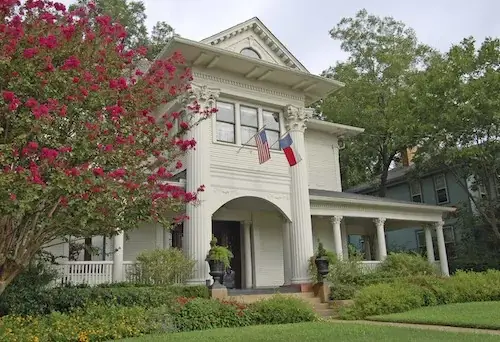
Overview of Texas Taxes
Texas has some of the highest property taxes in the U.S. The average effective property tax rate in the Lone Star State is 1.86%, the sixth highest rate of any state.
| Enter Your Location Dismiss | Assessed Home Value Dismiss |
| Average County Tax Rate 0.0% | Property Taxes $0 (Annual) |
| of Assessed Home Value | |
| of Assessed Home Value | |
| National | of Assessed Home Value |
- About This Answer
To calculate the exact amount of property tax you will owe requires your property's assessed value and the property tax rates based on your property's address. Please note that we can only estimate your property tax based on median property taxes in your area. There are typically multiple rates in a given area, because your state, county, local schools and emergency responders each receive funding partly through these taxes. In our calculator, we take your home value and multiply that by your county's effective property tax rate. This is equal to the median property tax paid as a percentage of the median home value in your county.
Texas Property Taxes

Texas has some of the highest property taxes in the U.S. The average effective property tax rate in the Lone Star State is 1.86%, the sixth highest rate of any state. Those taxes are the primary source of revenue for local governments, and fund local services like schools, water systems and law enforcement. In total, there are over 3,900 local entities who can collect property taxes in Texas. That includes every city, county and school district.
Looking to calculate your potential monthly mortgage payment? Check out our mortgage calculator.
How Do Texas Property Taxes Work?
Residential property in Texas is appraised annually by county appraisal districts. The appraisal districts are responsible for determining the current market value of all property within the county, on which tax payments are based. Disagreements about any findings are brought to an appraisal review board made up of local citizens.
Homes are appraised at the beginning of the year, and appraisal review board hearings generally begin in May. Tax bills are sent out beginning on Oct. 1, and are due by Jan. 31 of the following year.
There are a number of exemptions that help lower your property taxes in Texas. The most common is the homestead exemption, which is available to homeowners in their primary residence. It exempts at least $25,000 of a property’s value from taxation.
However, only school districts are required to offer this exemption (other types of taxing districts have the option of doing so). So if your home is worth $150,000 and you receive the homestead exemption, the school district tax rate will only apply to $125,000 of you home value.
Persons who are at least 65 or who are disabled can claim an additional exemption of $10,000. Like the homestead exemption, only school districts are required to offer this exemption.
Texas Property Tax Rates
Property tax rates in Texas are recalculated each year after appraisers have evaluated all the property in the county. They are calculated based on the total property value and total revenue need. In a given area, however, they typically do not change drastically year to year.
Texas levies property taxes as a percentage of each home’s appraised value. So, for example, if your total tax rate is 1.5%, and your home value is $100,000, you will owe $1,500 in annual property taxes.
In the table below, we look at each county’s effective tax rate, which is equal to the amount of property tax that homeowners actually pay as a percentage of their home’s value. The table also includes the average annual tax payment and average home value in each county.
For more information on the housing market in Texas, check out our comprehensive mortgage guide, which provides details about rates and getting a mortgage in Texas.
Harris County
Harris County, which contains Houston and the surrounding suburbs, has some of the highest property taxes not just in Texas but in the entire country. The average effective property tax rate in Harris County is 2.12%, significantly higher than the national average. That average rate incorporates all types of taxes, including school district taxes, city taxes and special district levies. The general countywide rate is 0.42%. The city rate in Houston is 0.58%.
The highest rates, however, are those levied by school districts. The Houston School District rate is about 1.21%. In combination with the city and county rates above, that means people in the city of Houston face a rate of at least 2.21%, plus any special district levies. In Pasadena, the second largest city in the county, the school district rate is 1.48%, and the city rate is 0.58%.
Dallas County
Property tax rates in Dallas County are slightly lower than those in Harris County, but still significantly higher than the national average. The average homeowner in Dallas County pays $2,861 annually in taxes, and pays taxes at an effective tax rate of 2.06%.
More than half of that tax goes to local schools. For example, in the city of Dallas, the total rate (without including any special levies) is 2.32%, but the school district rate alone is 1.28%.
Tarrant County
Tarrant County sits west of Dallas and contains the cities of Fort Worth and Arlington. It has the second highest property taxes in the entire state, with an average effective rate of 2.22%. That means that if your home is worth $200,000, you could expect to pay about $4,440 annually in taxes.
Property taxes are higher in Fort Worth than in Arlington. Residents of both cities pay the county’s general rate of 0.244%. In Fort Worth, however, the city rate is 0.805% and the school district rate is 1.352%. That adds up to a total rate of 2.401%. In Arlington, the total rate is about 2.252%.

Bexar County
The fourth largest Texas county by population, Bexar County has property taxes that are slightly higher than the state average. The average homeowner in Bexar County pays $2,721 annually in property taxes. In San Antonio, the county’s largest city and the second largest city in the entire state, the tax rate is 2.38%. That does not include any special districts. Many areas of Bexar County are subject to a levy to pay for one of 12 Emergency Services Districts. Those rates range from 0.05% to 0.10%.
Travis County
Travis County contains the state capital of Austin, as well as some of the surrounding cities and towns. The countywide property tax rate is 0.369%. In addition to that rate, cities and school districts levy their own rates. In Austin, the city rate is 0.4448% and the school district rate is 1.192%. That yields a total rate of 2.0058% (not including special districts). Other nearby cities have even higher rates. In Pflugerville, the total rate is over 2.4%. In Manor, the rate is more than 2.6%.
El Paso County
El Paso County is in western Texas, bordering both Mexico and the state of New Mexico. The average homeowner in the county pays $2,484 annually in property taxes, almost $300 more than the U.S. average. However, the average home value in El Paso County is significantly lower than the U.S. average, which means county residents in fact pay higher property tax rates than most Americans. The average effective property tax rate in El Paso County is 2.17%.
Collin County
The sixth most populous county in Texas, Collin County also has the fourth highest property taxes. This is driven largely by the high rates used to fund local school districts. The Plano Independent School District levies a property tax rate of 1.73%, contributing to the city’s total rate of 2.43%. The Frisco Independent School District rate is 1.63%, more than half of the total rate of 2.32%. Homeowners in these areas should remember to claim the homestead exemption.
Hidalgo County
Hidalgo County sits in south Texas, along the U.S. – Mexico border. The average effective property tax rate in Hidalgo county is 2.02%, 10th highest in the state. The county’s largest city, McAllen, has a total tax rate of 2.2113%. That includes the countywide levy of 0.58%, the city levy of 0.4763%, and the school district rate of 1.155%. It does not include any applicable special districts.
Denton County
Denton County is part of the Dallas-Fort Worth metropolitan area and sits north of those two cities. The average Denton County homeowner pays $4,195 annually in property taxes, on a median home value of $212,200. The city of Denton has some of the highest total property taxes in the area. When including city, county, and school levies, the total rate in the city of Denton is over 2.42%. In Lewisville, the county’s second largest city, the rate is lower – 2.08%.
Fort Bend County
Fort Bend County is the 10th largest county in Texas, but it has the highest average property tax payment in the state. The average homeowner in the county pays $4,879 each year in taxes. to the county’s average effective tax rate is 2.24%. These both rank first in the state of Texas, and they are more than double the national averages.
The high number of special tax districts in the county drive, in part, the high tax rates. Fort Bend County has more than 200 special districts that levy property taxes for specific purposes. In Sugar Land, the largest city in the county, the tax rate without including those districts is 2.09%.
Places Receiving the Most Value for Their Property Taxes
SmartAsset’s interactive map highlights the places across the country where property tax dollars are being spent most effectively. Zoom between states and the national map to see the counties getting the biggest bang for their property tax buck.
Methodology
Our study aims to find the places in the United States where people are getting the most value for their property tax dollars. To do this, we looked at property taxes paid, school rankings and the change in property values over a five-year period.
First, we used the number of households, median home value and average property tax rate to calculate a per capita property tax collected for each county.
As a way to measure the quality of schools, we analyzed the math and reading/language arts proficiencies for every school district in the country. We created an average score for each district by looking at the scores for every school in that district, weighting it to account for the number of students in each school. Within each state, we assigned every county a score between 1 and 10 (with 10 being the best) based on the average scores of the districts in each county.
Then, we calculated the change in property tax value in each county over a five-year period. Places where property values rose by the greatest amount indicated where consumers were motivated to buy homes, and a positive return on investment for homeowners in the community.
Finally, we calculated a property tax index, based on the criteria above. Counties with the highest scores were those where property tax dollars are going the furthest.
Sources: US Census Bureau 2018 American Community Survey, Department of Education
